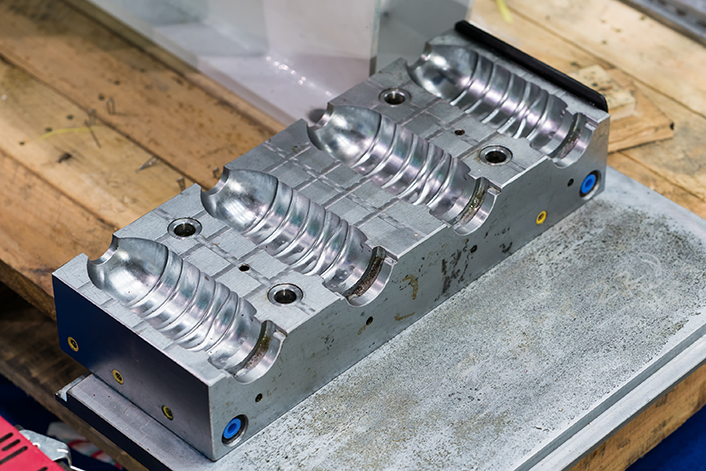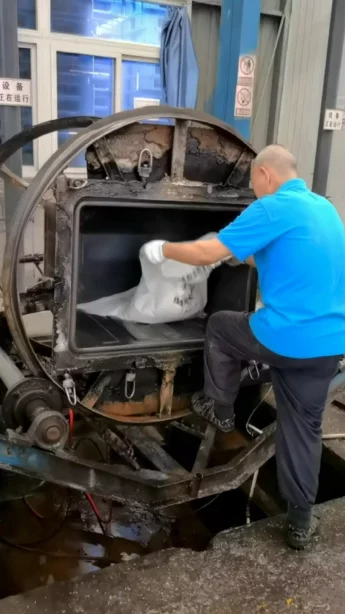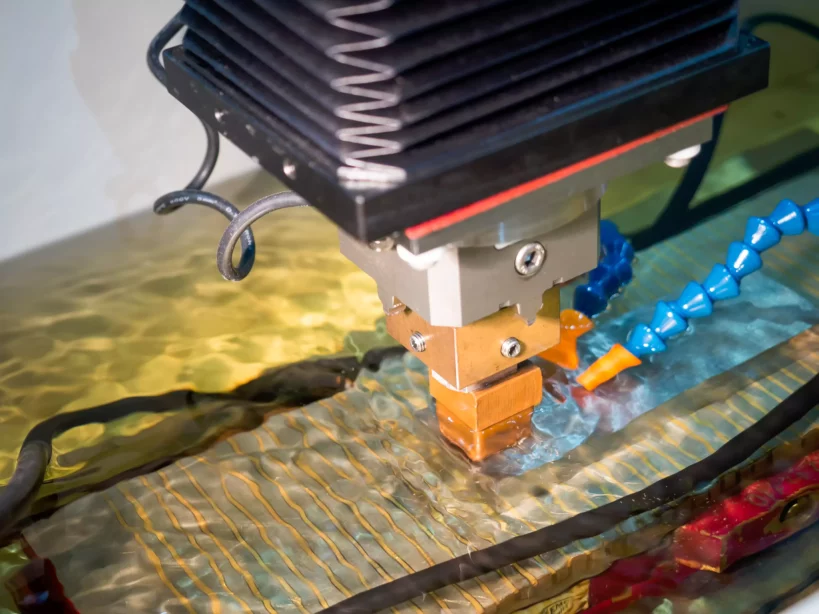How to Make Plastic Molds: Step-by-Step Guide
Common Types of Plastic Molds
In this section, we will provide an insightful overview of plastic molds, and their basic types. Plastic molds enable efficient mass production while ensuring dimensional stability and repeatability. Embracing the use of plastic molds revolutionizes the manufacturing process, leading to enhanced productivity and reduced costs.
1. Injection Molds
Injection molding is a manufacturing process that involves injecting molten material, typically plastic, into a mold cavity. The molten material is forced into the mold under high pressure, where it cools and solidifies, taking the shape of the mold. This process allows for the mass production of complex and precise plastic parts with consistent quality and high production efficiency. Injection molding is widely used in various industries due to its versatility, cost-effectiveness, and ability to produce intricate designs.
The molds consist of two halves, the core and the cavity, which are precisely machined to create the desired product shape. Molten plastic is injected under high pressure into the mold cavity, where it cools and solidifies, taking the shape of the mold. Due to the high-pressure and high-temperature corrosion endured by injection molds during the injection molding process, they need to be made of harder mold steels. The inner surface of the mold also often requires heat-resistant and corrosion-resistant surface treatment. Additionally, to ensure precision after thousands or even millions of injection cycles, the mold structure is also relatively complex.
2. Blow Molds

Blow molding is a specialized manufacturing process used to create hollow objects such as bottles, containers, and automotive components. It involves melting plastic resin and then inflating it into a mold cavity using compressed air. The mold, known as a blow mold, is a two-piece tool consisting of a core and a cavity, designed to shape the molten plastic into the desired form. The compressed air expands the plastic against the mold walls, allowing it to cool and solidify into the final product shape. Blow molding offers advantages such as cost-effectiveness, high production rates, and the ability to create complex geometries.
Compared with Injection molds, the blow molding operation pressure is relatively low, and the precision requirement is relatively low, also the blowing molding process does not heat the plastic to a molten stage, and hence the operating temperature is lower too. All these results in simpler molds and hence relatively less cost.
3. Compression Molds
Compression molds are used for molding thermosetting plastics. They involve placing a precise amount of plastic material into the mold cavity, followed by the application of pressure to evenly distribute the material. Heat is then applied to initiate the curing process, transforming the plastic into a solid state. After curing, the mold is opened, and the finished part is released. Compression molds are ideal for producing strong, intricate plastic components with excellent dimensional accuracy and surface finish. Compression molding is typically used for rubber, thermoset plastics, silicone rubber, and other material that cannot be re-molded once cured.
With some exceptions, the precision requirement of compression molds is normally not very high. The open and close mechanism is much simpler. As there is no high-pressure injection involved, the mold structure is much weaker and lighter. The cost is much cheaper than other plastic process molds.
4. Rotational Molds

Rotational molds, also called rotor-molds, are employed for producing sizable, hollow plastic parts. The manufacturing procedure starts with a heated mold that rotates on two axes. Liquid plastic material is poured into the mold, and the rotation spreads the plastic evenly across the interior surfaces. Once the mold cools, the plastic solidifies, resulting in the desired shape. Rotational molding is an ideal method for creating complex shapes with consistent wall thickness, making it suitable for manufacturing tanks, storage containers, and playground equipment. Its advantages include design flexibility, uniformity, and the elimination of assembly processes.
5. Thermoforming Molds
Thermoforming molds are used in a manufacturing process called thermoforming or vacuum forming. This process involves heating a plastic sheet until it becomes flexible and then placing it over a mold. By applying a vacuum or pressure, the plastic sheet is formed into the desired shape of the mold. After cooling, the formed plastic part is ejected from the mold. Thermoforming molds are commonly used for producing packaging materials, trays, and disposable cups.
In the vacuum forming process, the plastic only needs to be softened and does not need to be melted, so the temperature resistance requirements of the mold are not high. Since the product is formed through low pressure, the mold does not need to bear too much pressure, and the precision requirement is lower. Therefore, the mold does not have to be made of steel, but wood, aluminum, etc. can be used. The machining process is also easier and faster than other mold types. Therefore, the mold cost is low.
In the following sections, we take injection molds as an example to introduce the steps to make plastic molds.
How to Make Injection Molds? -7 Steps
Step 1. Select the appropriate molding material for the desired application.
Selecting the appropriate molding material is a critical step in how to make plastic molds. The choice of material depends on the desired application and specific requirements. Factors to consider include mechanical properties, chemical resistance, temperature resistance, dimensional stability, and cost. Common molding materials include thermoplastics, such as polyethylene, polypropylene, and polystyrene, which offer flexibility, durability, and ease of processing. For specialized applications, thermosetting plastics like epoxy or phenolic resins may be suitable, providing heat resistance and dimensional stability. Additionally, engineering plastics like ABS, nylon, or polycarbonate offer enhanced strength and performance. Careful consideration of material properties ensures that the mold can effectively produce high-quality parts that meet the application’s functional and aesthetic requirements.
Step 2. Design concepts and create a 3D model of the mold.
All mold designs start from the 3D model of the plastic parts that need to be made. Once the material is chosen, the shrink rate is known. Modern CAD software can easily form mold designs from 3D models of plastic parts. Of course, the mold designer still needs to consider many engineering issues, such as the wall thickness of the part, shrink rate, whether there is enough space for the slider, where the parting line will not affect the appearance, etc. More complex molds also need to use professional mold flow software for mold flow analysis to ensure that there will be no quality problems in the production process of parts. The choice of mold core material also requires professional judgment, and the influencing factors include mold life, the corrosiveness of plastic materials, and so on. Capable Machining has a professional mold designer team with decades of mold designing experience, we just mold right.
Step 3. Fabricate the mold using CNC machining, EDM, and other processes.

Modern mold production has long been specialized. The mold base has been standardized, and there are also professional manufacturers specializing in the production of various mold accessories such as plates, thimbles, and cylinders. Even the supply of raw materials for the cores has been semi-standardized. Various mold sheets of steel with a precision of up to 10um are processed by professional suppliers and then sent to mold manufacturers(such as us).
Depending on the plastic parts and mold requirement, manufacturers will use CNC machining(for unhardened steel)or EDM(for hardened steel or complicated shapes)to make the mold cavity. Sometimes we also have to make none standard mold accessories.
Step 4. Prepare the mold surface by polishing or applying coatings.
Based on the different requirements of injection molding materials, surface textures, and overall mold lifespan, the mold cavity often requires various surface treatment methods to enhance the appearance of the injection molded parts or improve the mold’s corrosion resistance. Common surface treatment methods include texture etching, sandblasting, polishing, and various types of coatings.
Step 5.Mold Assembly: align and secure mold components for precise molding.
The assembly process begins with the careful positioning and alignment of mold plates, which form the outer structure of the mold. The next step involves the installation of cores and cavities, which define the shape of the molded part. These components must be precisely positioned and securely fastened to ensure accurate molding.
Additionally, the assembly includes the integration of ejector systems, which facilitate the removal of the molded part from the mold cavity. Cooling channels, designed to regulate the temperature of the mold during the injection process, are also installed during assembly. Other elements, such as guide pins, screws, and connectors, are incorporated to ensure proper alignment and stability of the mold components. During the assembly process, close attention is paid to the fit and clearance between components to minimize any potential for misalignment or interference. Once all the components are in place, they are securely fastened, typically using bolts, screws, or clamping systems.
Injection mold assembly requires skilled technicians or mold makers who possess a deep understanding of mold design and functionality. Their expertise ensures the precise alignment of components, proper integration of systems, and overall functionality of the mold. A well-assembled injection mold is crucial for achieving high-quality, consistent, and defect-free plastic parts during the injection molding process.
Step 6.Mold Test: conduct thorough testing and validation of the mold.
Similar to other engineering works, molds need to undergo testing to ensure their proper functionality. The testing process for molds is similar to the injection molding production process. Plastic material is added to the injection molding machine, and various parameters of the machine are adjusted for injection molding. If the molded product does not meet the desired expectations, improvements to the mold are necessary. With years of experience in mold manufacturing, coupled with modern mold design and mold flow analysis software, we have significantly reduced the occurrence of major issues during the trial molding stage. However, occasional mold adjustments are still sometimes necessary. By completing these steps, the manufacturer ensures that the plastic part meets the intended specifications and is ready for use or assembly.
Step 7. Repeat the process for additional molds or production runs.
The last step involves repeating the entire process of creating additional molds or carrying out production runs. Once a mold has been successfully used to produce a plastic part, it can be reused to manufacture more parts. This step involves preparing the mold, setting up the molding machine, injecting or pouring the molten plastic material, applying pressure or cooling, opening the mold, and removing the finished parts. By repeating this process, manufacturers can mass-produce plastic parts, ensuring consistent quality and meeting the required production volumes. It allows for efficient and cost-effective manufacturing of large quantities of plastic components for various industries and applications.
In conclusion, understanding the common types of plastic molds and learning how to make plastic molds like making injection molds with the step-by-step process is crucial for successful mold fabrication. The process of making injection molds requires careful consideration of material selection, precise mold design, fabrication using advanced techniques, surface treatment, meticulous assembly, thorough testing, and repetition for mass production. By following these steps, manufacturers can create high-quality molds that enable efficient and cost-effective production of plastic parts. Successful mold-making ensures the realization of precise designs and the fulfillment of specific application requirements, contributing to the advancement of various industries.
One comment
Leave a Comment
You must be logged in to post a comment.
We wish to thank you all over again for the beautiful ideas you offered Jeremy when preparing her post-graduate research and, most importantly, with regard to providing all of the ideas in a single blog post. Provided that we had known of your website a year ago, we’d have been saved the useless measures we were employing. Thanks to you.